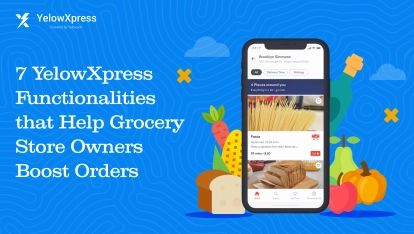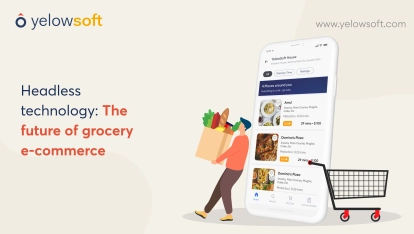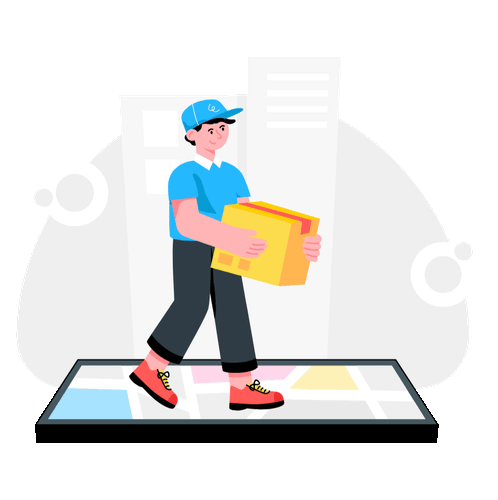Online grocery shopping is no longer a niche—it’s the new standard.
Forecasts show that the online grocery delivery market will grow by US $1.12 trillion between 2023 and 2028, at a 25.2% CAGR. (Source)
Another report predicts the overall market will surge from US $595.6 billion in 2024 to US $3.61 trillion by 2033, at a 22.17% CAGR. (Source)
Consumers now expect fast, reliable, and tech-driven grocery experiences.
If you want to stay competitive, invest in on demand grocery software that streamlines ordering, delivery, and inventory.
In this guide, you’ll learn how grocery stores are digitally transforming with grocery delivery app development, the business models succeeding in 2025, and when to use online grocery store software vs custom builds.
Let’s get started on your digital transformation journey.
Top Trends in Online Grocery Shopping (2025 Edition)
If you’re planning to grow your grocery business this year, you can’t ignore these trends.
They’re not just buzzwords. They reflect how customer behavior, technology, and expectations are shifting in real time.
Let’s break them down.
1. Mobile-First Shopping Is the New Normal
Most customers today place grocery orders using mobile apps. A mobile-optimized experience is no longer optional. It’s a baseline.
This is where grocery delivery app development plays a critical role. A well-designed app makes browsing, reordering, and checkout seamless.
It also builds loyalty, especially when paired with smart push notifications, real-time tracking, and personalized deals.
2. Subscription-Based Ordering Grows
Shoppers love convenience. Subscriptions for essentials like milk, eggs, or baby products are rising fast.
These recurring orders are often powered by smart grocery order management software that automates schedules and inventory sync.
As a grocery operator, this helps you reduce cart abandonment and boost predictable revenue.
3. AI Is Powering Personalization
Artificial intelligence is not a future concept. It’s here.
From AI-powered recommendations to smart reordering reminders, the most successful grocery apps use AI to drive conversions.
Smart online grocery store software uses AI to personalize offers, predict product demand, and create tailored customer experiences that keep people coming back.
4. Real-Time Delivery Tracking Is Expected
Consumers don’t want to “wait and wonder.” They want real-time visibility.
That’s why modern delivery app development for grocery stores now includes GPS tracking, ETA alerts, and driver communication features.
It’s not just about delivering groceries. It’s about delivering trust.
5. Seamless Payments Are a Must
Whether it's card, wallet, or buy-now-pay-later options, smooth payment flow is essential.
You should consider flexible payment integrations for grocery apps to improve checkout success and customer satisfaction.
Apps with clunky payment systems lose users. Period.
These trends prove one thing—customers want more control, speed, and convenience. And it’s your backend systems that enable that.
Let’s now explore the types of business models and platforms powering the next generation of online grocery stores.
Choosing the Right Business Model for Your Grocery App in 2025
Before you even start building your app, you need to figure out how you're going to run and make money from it.
Let’s walk through the main business models you can choose from. And I’ll help you decide what fits best for your store.
1. Inventory-Based Model
This one’s straightforward.
You own the inventory. You manage stock, update prices, and fulfill the orders. If you run a local grocery store with online ordering systems, this model might already sound familiar.
It works best if:
- You want full control over product availability and delivery speed
- You already have warehouse or in-store fulfillment teams
But keep in mind, managing inventory means more overhead. You’ll need smart grocery order management software to keep everything organized and prevent stockouts.
2. Marketplace Model
Here, you don’t stock anything yourself. Instead, you list products from other grocery vendors and act as the bridge between them and the customer.
Think of it like becoming the “Uber Eats” of grocery delivery.
Pros:
- Faster to launch
- Less operational risk
Cons:
- Lower margins
- Customer experience depends on your sellers
If you want to scale quickly without managing inventory, this is worth exploring. Especially when built on flexible on demand grocery software.
3. Hybrid Model (The Best of Both)
This is the model I’d recommend if you’re looking to grow.
You manage inventory for some products, but also bring in third-party sellers to expand your catalog. It gives you the flexibility of a marketplace while retaining control where it matters.
You’ll need the right grocery delivery app development approach to handle both workflows seamlessly. But once it’s set up — it’s a revenue engine.
Monetization Tactics to Layer In
No matter which model you choose, don’t forget to add:
- Delivery fees (based on time slots or order value)
- Subscription tiers (for free delivery or loyalty rewards)
- Ad placements for vendors on your app
- Commission-based earnings (in marketplace models)
And yes — all of these can be handled within a modern online grocery store software platform.
Once you know what business model you’re going with, the next step is choosing how you’ll actually build and launch your platform.
Should you go for a SaaS solution or custom development? Let’s break that down next.
SaaS vs Custom Grocery App Development: What You Should Choose in 2025
Now that you know your business model, the big question is — how do you build it?
Should you hire a team to code your app from scratch?
Or use a proven on demand grocery software that’s already battle-tested?
Let’s look at both paths and help you decide.
SaaS vs Custom Grocery App Development: What You Should Choose in 2025
| Feature / Factor | Custom Grocery App Development | SaaS-Based Grocery App Solutions |
|---|---|---|
| Cost | High upfront cost (developers, QA, design, backend) | Lower cost with monthly/annual subscription |
| Development Effort | You manage everything from scratch | Pre-built, tested solution ready to go |
| Feature Availability | Every new feature = more dev time | Built-in features like order tracking, payments, analytics |
| Maintenance | You're responsible for updates, bug fixes, and scaling | Handled by the SaaS provider with regular updates |
| Best For | Large enterprises with big budgets and tech teams | Growing stores that want speed, savings, and ease |
| Tech Risk | High – requires project management and tech oversight | Low – software is already battle-tested |
Still Need Customization? No Problem
Modern SaaS solutions aren’t “rigid.” SaaS Grocery Solution like Yelowxpress let you:
- Customize your branding and interface
- Set up custom workflows and fees
- Integrate with tools like Zoho, Razorpay, or Stripe
So you’re not stuck with one layout. You just skip the hard part wihtout building it from scratch.
Now that you know how to build it, let’s zoom in on the must-have features every grocery app should offer — whether you’re running a local shop or a multi-location chain.
Must-Have Features in a 2025 Grocery Ordering System
If you’re serious about growth in 2025, your platform needs more than just a cart and checkout. You need features that keep customers coming back, streamline operations, and give you full control.
Here’s a breakdown of what your system must include and why it matters to your success:
Smart Product Catalog Management
Easily update prices, stock levels, product images, and categories in one place. This is the backbone of any scalable grocery order management software.
Real-Time Inventory Tracking
Avoid frustrating “out of stock” errors. Track inventory live and sync it across locations if you have multiple stores.
Delivery Slot Booking & Route Optimization
Give your customers the power to choose delivery time slots. Optimize driver routes using delivery app development for grocery stores that reduce delays and increase drop efficiency.
Seamless Payment Integrations
Your system should support digital wallets, credit cards, bank transfers, and even payment integrations for grocery apps like Stripe or Razorpay — securely and smoothly.
Live Order Tracking for Customers
Today’s shopper expects to see where their order is and when it will arrive. Live tracking builds trust and reduces customer support calls.
Sales Analytics & Business Reports
Access easy-to-read dashboards to monitor sales, customer behavior, and repeat orders. Choose grocery order management software that gives you real business intelligence.
Multi-Zone and Multi-Store Support
If you plan to grow regionally, make sure your software lets you manage multiple stores and delivery zones from a single dashboard.
Mobile App for iOS and Android
Mobile-first is a must. A branded app boosts loyalty, lets you send push notifications, and provides a better user experience.
Admin Roles and Access Control
Assign roles to your team — managers, delivery agents, warehouse staff with the right permissions. This keeps operations secure and efficient.
AI-Powered Product Recommendations
Increase average order value with intelligent suggestions based on past purchases and cart history.
Together, these features don’t just help you survive. They help you scale.
A strong grocery store with online ordering systems built on these essentials will outperform competitors and earn long-term loyalty.
Conclusion
The digital transformation of online grocery shopping and stores in 2025 is not just about selling groceries online. It is about changing the way you run your business to match how your customers want to buy today.
From using on demand grocery software to building a seamless grocery store with online ordering systems, success now depends on choosing the right tools and partners.
Whether it is about speeding up deliveries, offering multiple payment options, or managing your stock in real time, the right platform will help you stay ahead.
If you are a growing business, trying to handle everything manually will only hold you back. Now is the moment to upgrade your tech, simplify your processes, and deliver a better customer experience.
Your customers expect speed, reliability, and convenience. With the right grocery delivery app development strategy, you can offer all of that and more.
Let this year be the turning point where your store moves from being reactive to being ready for the future.
Bring digital transformation to your store operations with Yelowxpress
Frequently Asked Questions (FAQs)
Start with a strong niche, build your catalog, and choose an on demand grocery software that supports real-time tracking, payments, and scalability from day one.
Unless you have a big team and deep pockets, go for a white-label grocery delivery app. It’s faster, cheaper, and already tested by other businesses.
Use grocery order management software that syncs inventory across stores, warehouses, and the app in real time.
Must-haves include delivery slot booking, live tracking, payment integration, and a mobile-first interface.
Yes. Most online grocery store software supports payment integrations for grocery apps like Stripe, PayPal, and Razorpay out of the box.
With SaaS-based grocery delivery app development, you can go live in 2–4 weeks. Custom apps can take 6 months or more.
Custom apps can cost $50k to $200k+. SaaS platforms are subscription-based, making them more affordable for growing stores.
Yes. Choose a grocery store with online ordering systems that supports multi-zone and multi-store configurations.
Use software that offers SSL encryption, two-factor authentication, and secure payment gateways. Most SaaS tools already follow best practices.
Look for on demand grocery software with order tracking, delivery support, and analytics — without complex setup.





